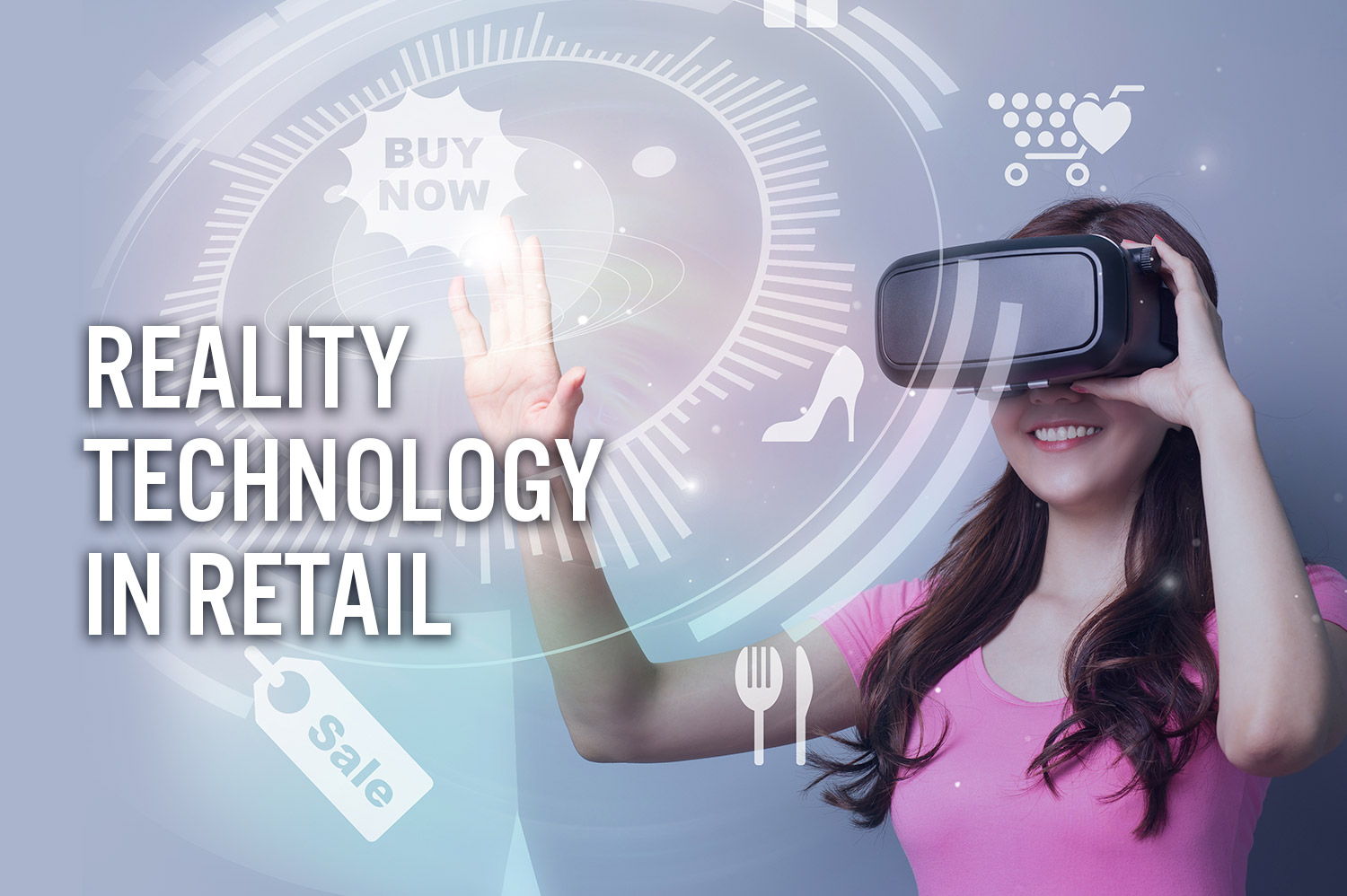
DIpil Das
https://youtu.be/dV1QktY_D7I
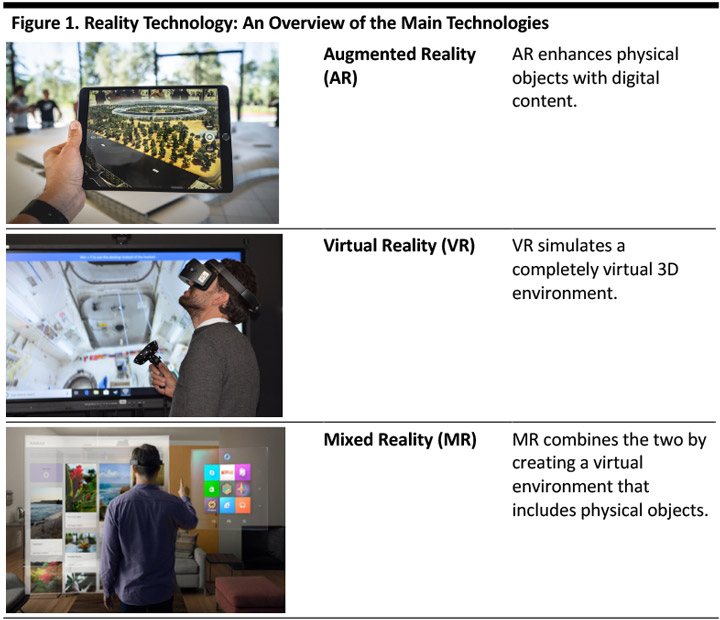 Source: Unsplash.com/Microsoft/Coresight Research [/caption]
Retail is already exploring the potential of reality technology. Market research firm IDC estimated that in 2018 total AR and VR spending globally amounted to $17.8 billion, of which $516 million was spent on retail industry applications, making the sector one of the top investors in the category with over 29% of the total spend.
Technology companies with strong retail operations such as Amazon and Alibaba are particularly active in reality technology research and development (R&D), as shown in Figure 2 below, but also legacy retailers such as Walmart show significant R&D activity in the field, as they try to keep up with competitors.
[caption id="attachment_90231" align="aligncenter" width="720"]
Source: Unsplash.com/Microsoft/Coresight Research [/caption]
Retail is already exploring the potential of reality technology. Market research firm IDC estimated that in 2018 total AR and VR spending globally amounted to $17.8 billion, of which $516 million was spent on retail industry applications, making the sector one of the top investors in the category with over 29% of the total spend.
Technology companies with strong retail operations such as Amazon and Alibaba are particularly active in reality technology research and development (R&D), as shown in Figure 2 below, but also legacy retailers such as Walmart show significant R&D activity in the field, as they try to keep up with competitors.
[caption id="attachment_90231" align="aligncenter" width="720"]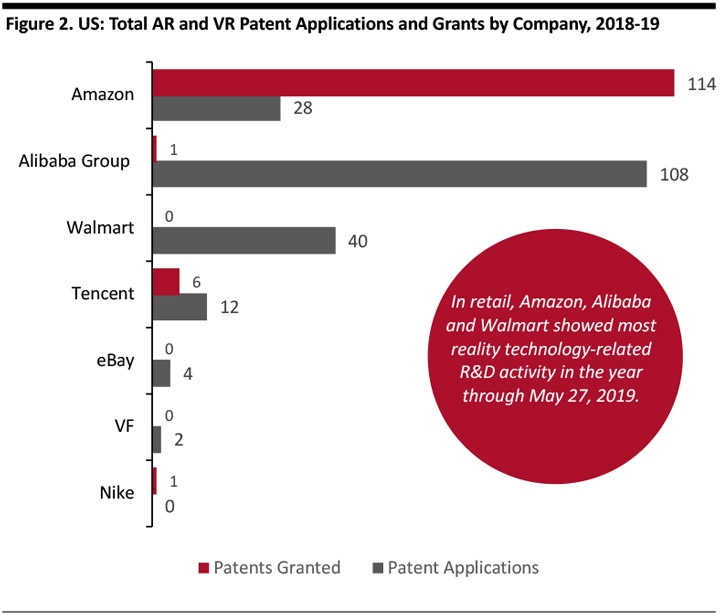 One year through May 27, 2019. Based on data for selected major retail companies
One year through May 27, 2019. Based on data for selected major retail companies
Source: Grata Data [/caption] Greater adoption of reality technology in retail is expected to change the way consumers interact with brands and retailers. In particular, reality technology in retail can be deployed as a tool to enhance the shopping experience, by enabling consumers to virtually try a product or service before finalizing the purchasing decision. The three types of reality technology suit different business cases. AR can enhance the in-store shopping experience and consumer engagement, while VR and MR — because of the immersive experience — appeal mainly to retailers selling big-ticket items or services and experiences with relatively high price points — such as furniture, real estate, automotive and holidays. The benefit is being able to let customers virtually experience the product or service they are considering buying.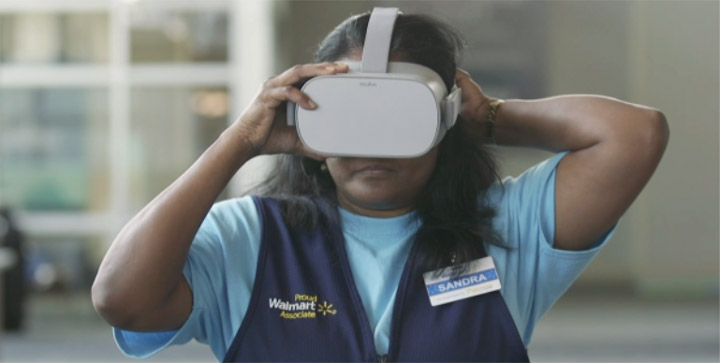 Source: Walmart.com[/caption]
US department store Macy’s entered into a partnership with reality technology specialist Marxent in October 2018 to install over 70 VR installations across the US. The technology, See Your Space In Real Life, helps customers discover products and make informed purchase decisions. Using a VR headset, customers can immerse themselves in virtual rooms. Shoppers provide measurements for rooms in their homes, pick the pieces and start to design rooms on a screen – allowing them to see how pieces will look vis the digitally recreated virtual environment. And, users can share digital images with friends on social media for real-time feedback.
[caption id="attachment_90233" align="aligncenter" width="720"]
Source: Walmart.com[/caption]
US department store Macy’s entered into a partnership with reality technology specialist Marxent in October 2018 to install over 70 VR installations across the US. The technology, See Your Space In Real Life, helps customers discover products and make informed purchase decisions. Using a VR headset, customers can immerse themselves in virtual rooms. Shoppers provide measurements for rooms in their homes, pick the pieces and start to design rooms on a screen – allowing them to see how pieces will look vis the digitally recreated virtual environment. And, users can share digital images with friends on social media for real-time feedback.
[caption id="attachment_90233" align="aligncenter" width="720"]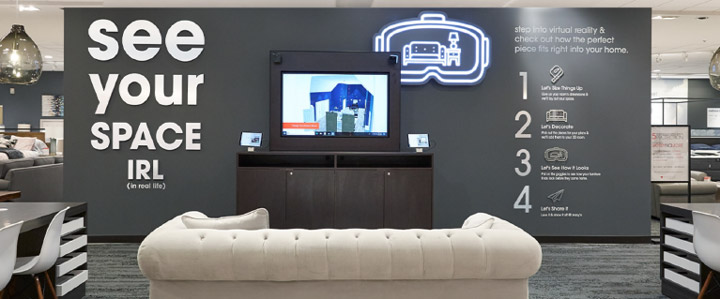 Macy’s See Your Space IRL
Macy’s See Your Space IRL
Source: macys.com [/caption] US home improvement retailer Lowe’s, together with Canadian tech-company Finger Food Studios, launched View in Your Space in March 2018. View in Your Space in an AR platform that shows how a product will look in the shoppers’ homes. Shoppers simply scan the environment through the Lowe’s app to see how different products would look. Lowe’s research found it takes several weeks for shoppers to decide whether to buy big-ticket items, such as a grill or garden furniture, a friction point the company believes keeps an estimated $70 million in home improvement projects on standby. (The source did not specify a timeframe for the estimated missed revenue from the projects on hold.) The only downside is that shoppers need a mobile device with ARCore to use the feature via the Lowe’s app. [caption id="attachment_90234" align="aligncenter" width="720"]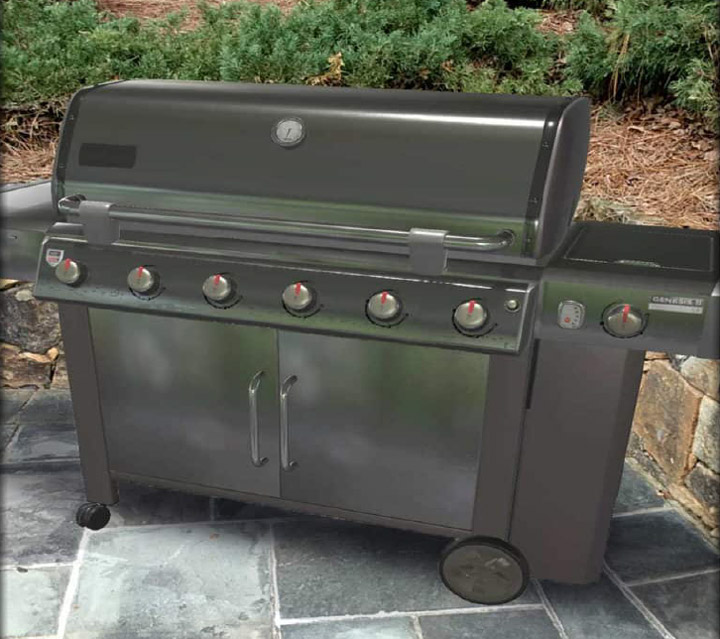 Lowe’s View in Your Space showing how a barbeque would look in the shoppers’ backyard
Lowe’s View in Your Space showing how a barbeque would look in the shoppers’ backyard
Source: lowes.com [/caption] In 2016, Lowe’s launched Vision App together with Google and Lenovo. The platform enabled customers to easily measure any room in the home and style it with virtual Lowe’s products in real-time through AR. Google-powered the app through its Tango AR computing platform, while Lenovo provided compatible hardware embedding Tango through its Phab 2 Pro Smartphone (the device is no longer available at the time of writing). [caption id="attachment_90235" align="aligncenter" width="720"]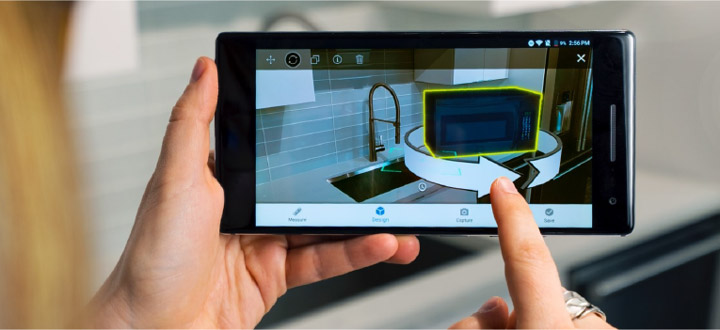 Lowe’s Vision app
Lowe’s Vision app
Source: fingerfoodstudios.com [/caption] Sports apparel brand and retailer Lululemon, in collaboration with Finger Food Studios, is applying VR to give customers visiting the company’s shops a meditative-like experience through The Recovery Hub platform. Users wear a headset and headphones and are transported into a virtual mountain scene. A wristband sensor measures the customer’s heart rate, unleashing relaxing images such as campfires and northern lights that encourage relaxation. The program, called EmbodyRelax, is a VR experience that uses customer biometrics to monitor a variety of vital signs that indicate stress levels within a dynamic virtual environment. Lululemon launched Recovery Hub in Toronto, New York and London as well as at pop-up events at the LA Marathon, the Boston Marathon, the Superbowl and in-store events in Seoul during the Winter Olympics. [caption id="attachment_90236" align="aligncenter" width="720"]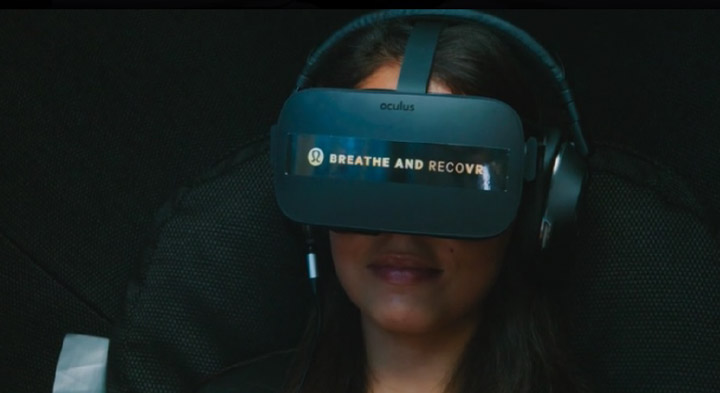 Lululemon’s The Recovery Hub
Lululemon’s The Recovery Hub
Source: fingerfoodstudios.com [/caption] VR and AR technology allow consumers to try products before buying without the need to go to the store. AR makes the task of visualizing products easier. Perhaps because of these characteristics, the beauty industry was one of the first to see the potential of commercial application of the technology. Beauty giant L’Oréal acquired AR beauty tech startup ModiFace in 2018 to create new AR shopping experiences through Facebook platforms. In 2017 beauty companies Sephora and Estée Lauder partnered with ModiFace to create custom AR beauty apps. In particular, ModiFace developed for Sephora the Virtual Artist feature for the retailer’s mobile app. This AR platform allows users to upload a selfie and virtually try on cosmetics. ModiFace developed for Estée Lauder a chatbot using FaceBook Messenger platform that uses artificial intelligence (AI) to give advice and AR to allow the customer to virtually try-on products. [caption id="attachment_90237" align="aligncenter" width="720"]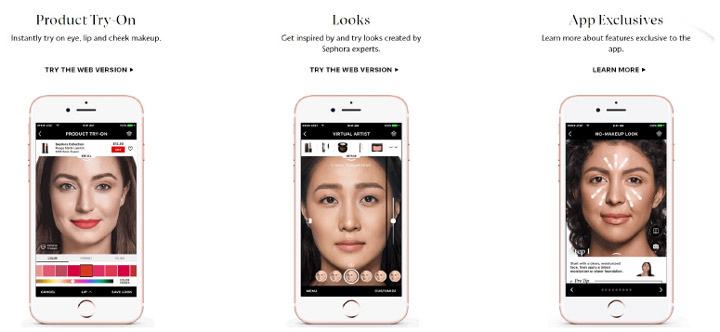 Sephora Visual Artist Web Pag
Sephora Visual Artist Web Pag
Source: sephoravirtualartist.com [/caption] Furniture retailer Ikea is an early adopter of AR and VR platforms to enable customers to see how furniture would look in the home. Ikea pioneered the application of reality technology in retail in 2013 when the furniture retailer launched an AR app in conjunction with the company’s printed catalog. In 2017, Ikea launched Ikea Place, an AR app that lets customers see how more than 2,000 furniture pieces would fit in their homes. Shoppers simply scan their room through the app, browse for items, select the item and move the image around the room to see where the item would fit best. Users can share images on social media for feedback from family and friends. [caption id="attachment_90238" align="aligncenter" width="720"]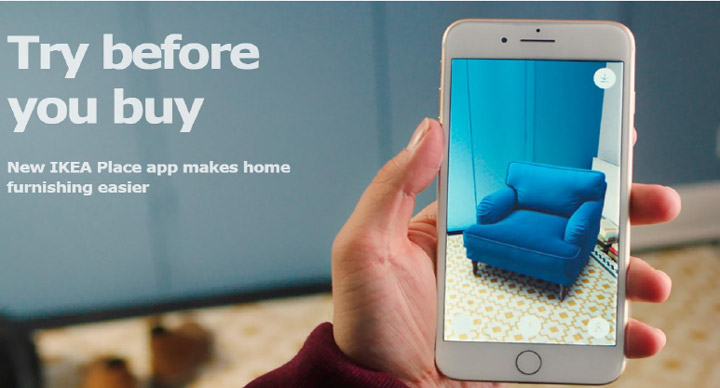 Ikea Place App
Ikea Place App
Source: Ikea.com [/caption] By the end of 2019 Ikea will launch a new AR-powered product visualization app that will enhance the features already available on Ikea Place, Reuters reported on May 27, 2019. With the new app, shoppers will be able to virtually visualize more than one item at a time to see how entire interior settings would look – and the ability to buy directly from the app. With the current Ikea Place app, shoppers can only visualize products one at a time, and add items to a shopping list for later purchases in a store. The new app is part of the retailer’s strategy of gradually shifting the focus of its distribution network from big, out-of-town outlets to smaller omnichannel urban stores and online shopping. In addition to its AR apps, Ikea also launched a VR platform—Virtual Home Experience—an interactive showroom that uses the technology to let customers virtually visualize how Ikea products would look in their homes. The platform—developed with digital agency Demodern—was launched in 2016. [caption id="attachment_90239" align="aligncenter" width="720"]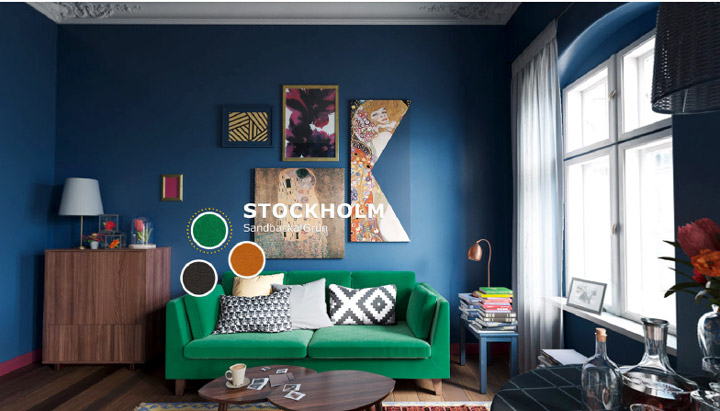 Ikea’s Virtual Home Experience
Ikea’s Virtual Home Experience
Source: demodern.com [/caption]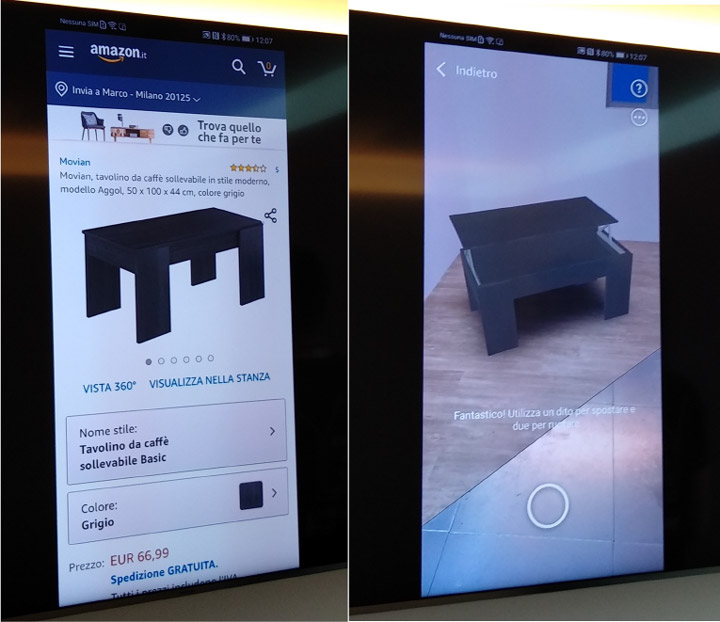 Amazon’s View In Your Room Feature in Action at Milan Design Week 2019 Source: Coresight Research
Amazon’s View In Your Room Feature in Action at Milan Design Week 2019 Source: Coresight Research
[/caption] Alibaba has been experimenting with reality technology extensively and we expect the company to continue to find new uses for the technology in the future as part of its New Retail strategy, which aims to blend physical and online retail. In collaboration with Microsoft, Alibaba announced the launch of Taobao Buy — also known as Taobao Maia — a new shopping experience that combines physical and virtual retailing through AR and MR. The platform lets shoppers see 3D reproductions of products sold on Alibaba’s online marketplaces in a physical space of 3,200 square feet located in a shopping district in Hangzhou, China. Microsoft’s HoloLens MR headset is used by the platform to virtually browse items available for purchase online. In August 2018, Alibaba announced the launch of Taobao Buy, planned for the Creativity Festival in Hangzhou, which took place in September 2018. [caption id="attachment_90241" align="aligncenter" width="720"]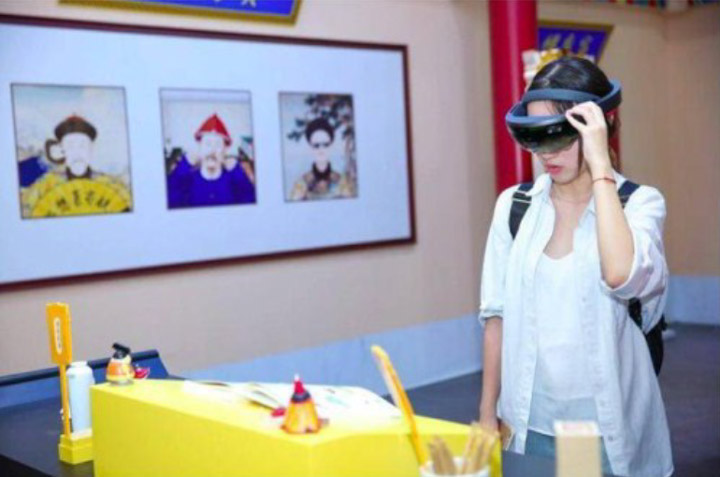 Taobao Buy MR platform at Creativity Festival in Hangzhou
Taobao Buy MR platform at Creativity Festival in Hangzhou
Source: ehangzhou.gov.cn [/caption] On May 24, 2018, Alibaba announced the acquisition of a minority stake in Ordre, a European online luxury wholesale platform, according to Alizila. The technology enables fashion designers to create virtual showrooms to showcase creations to wholesale buyers. Dianne Von Furstenberg, Vivienne Westwood and Jason Wu have already opened digital showrooms on Ordre. In 2016 Alibaba introduced the shoppable VR through Buy+, a VR set that can simulate a shopping journey at iconic destinations such as the Macy’s store on 34th Street in New York. [caption id="attachment_90242" align="aligncenter" width="720"]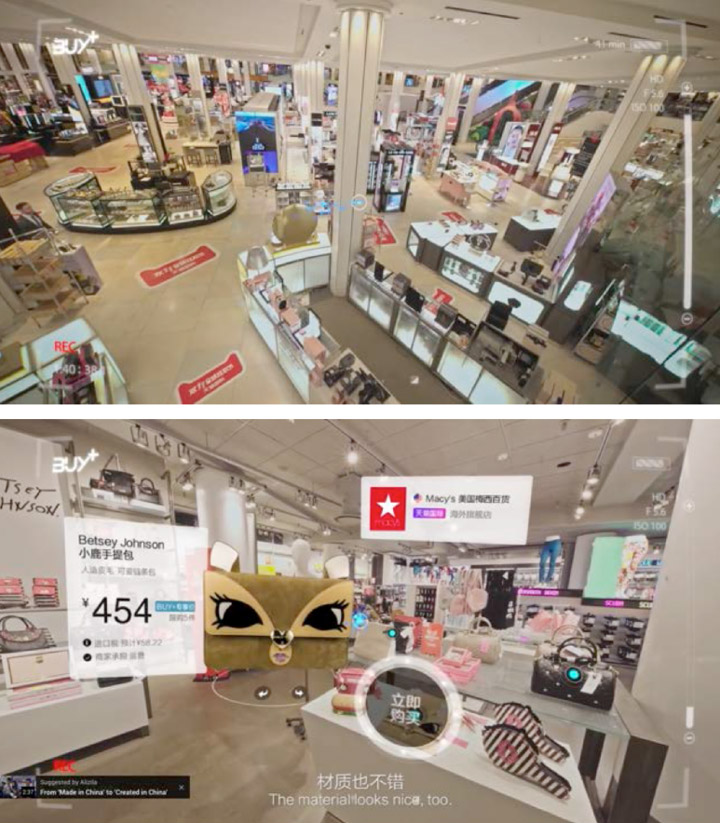 Macy’s virtually browsed by shoppers using Alibaba’s Buy+ platform
Macy’s virtually browsed by shoppers using Alibaba’s Buy+ platform
Source: Alibaba Group [/caption]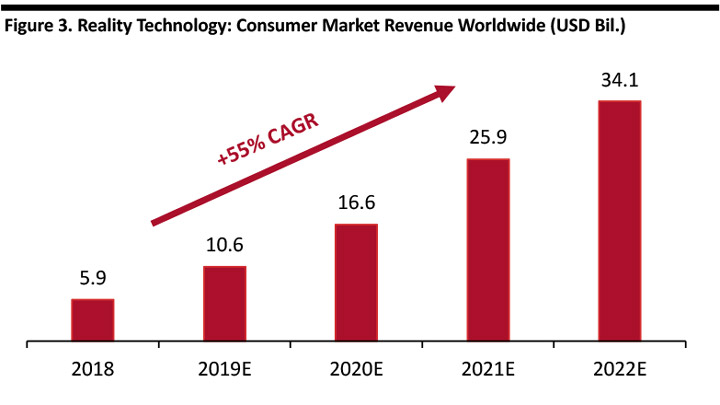 Source: SuperData Research/Coresight Research[/caption]
The acceleration of reality technology in retail will also depend on the advent of technologies such as 5G, a new mobile platform which is expected to significantly improve the infrastructure on which VR, AR and MR operate and to enable more advanced uses. 5G is expected to deliver the enhanced mobile connectivity needed to unleash the full potential of data-intense applications such as reality technology that today’s mobile technology cannot support.
5G’s enhanced connectivity will improve the quality of the content in VR, AR and MR platforms, and make it possible for shoppers in a dense space — such as a busy store — to experience the technology simultaneously with other shoppers without compromising the quality of the experience, making the rollout of the technology in physical retail spaces more viable. In our report 5G in Retail we provide a thorough analysis of how the retail industry will benefit from the advent of the new mobile connectivity technology.
Source: SuperData Research/Coresight Research[/caption]
The acceleration of reality technology in retail will also depend on the advent of technologies such as 5G, a new mobile platform which is expected to significantly improve the infrastructure on which VR, AR and MR operate and to enable more advanced uses. 5G is expected to deliver the enhanced mobile connectivity needed to unleash the full potential of data-intense applications such as reality technology that today’s mobile technology cannot support.
5G’s enhanced connectivity will improve the quality of the content in VR, AR and MR platforms, and make it possible for shoppers in a dense space — such as a busy store — to experience the technology simultaneously with other shoppers without compromising the quality of the experience, making the rollout of the technology in physical retail spaces more viable. In our report 5G in Retail we provide a thorough analysis of how the retail industry will benefit from the advent of the new mobile connectivity technology.
Introduction: Reality Technology Provides Immersive Shopping Experiences
Reality technology gives users an immersive experience that digitally recreates physical experiences and blends digital objects with physical environments. Retail already sees the potential applications of this new technology. Retailers have started to offer reality technology platforms to enrich the shopping journey with tools that can inform shoppers’ decision-making process — for example by virtually replicating what it is like to use the product or service. In the coming years, reality technology could disrupt retail by changing the way consumers shop. This report provides an overview of the application of reality technology in retail. We illustrate notable examples of how retailers have introduced reality technology as a tool to provide better customer service. We describe the collaboration between retailers, technology firms and startups to implement the technology and highlights the prospects for further, more advanced applications of reality technology in retail.Reality Technology to Become More Commonplace — and a Disruptor
Reality technology — also defined as immersive technology — describes the platforms that use digital technology to emulate physical objects and real-life experiences. There are three types of reality technology that digitally simulate the user’s environment: augmented reality (AR), virtual reality (VR) and mixed reality (MR), as summarized in Figure 1. [caption id="attachment_90230" align="aligncenter" width="720"] Source: Unsplash.com/Microsoft/Coresight Research [/caption]
Retail is already exploring the potential of reality technology. Market research firm IDC estimated that in 2018 total AR and VR spending globally amounted to $17.8 billion, of which $516 million was spent on retail industry applications, making the sector one of the top investors in the category with over 29% of the total spend.
Technology companies with strong retail operations such as Amazon and Alibaba are particularly active in reality technology research and development (R&D), as shown in Figure 2 below, but also legacy retailers such as Walmart show significant R&D activity in the field, as they try to keep up with competitors.
[caption id="attachment_90231" align="aligncenter" width="720"]
Source: Unsplash.com/Microsoft/Coresight Research [/caption]
Retail is already exploring the potential of reality technology. Market research firm IDC estimated that in 2018 total AR and VR spending globally amounted to $17.8 billion, of which $516 million was spent on retail industry applications, making the sector one of the top investors in the category with over 29% of the total spend.
Technology companies with strong retail operations such as Amazon and Alibaba are particularly active in reality technology research and development (R&D), as shown in Figure 2 below, but also legacy retailers such as Walmart show significant R&D activity in the field, as they try to keep up with competitors.
[caption id="attachment_90231" align="aligncenter" width="720"] One year through May 27, 2019. Based on data for selected major retail companies
One year through May 27, 2019. Based on data for selected major retail companies Source: Grata Data [/caption] Greater adoption of reality technology in retail is expected to change the way consumers interact with brands and retailers. In particular, reality technology in retail can be deployed as a tool to enhance the shopping experience, by enabling consumers to virtually try a product or service before finalizing the purchasing decision. The three types of reality technology suit different business cases. AR can enhance the in-store shopping experience and consumer engagement, while VR and MR — because of the immersive experience — appeal mainly to retailers selling big-ticket items or services and experiences with relatively high price points — such as furniture, real estate, automotive and holidays. The benefit is being able to let customers virtually experience the product or service they are considering buying.
How Legacy Retailers Implement Reality Technology
Legacy retailers collaborate with technology firms and startups to develop and implement reality technology solutions. Firms such as Microsoft and Google have also been working with retailers to develop retail-tech platforms. Collaborating with tech companies and startups lets legacy retailers more easily adopt the technology, boosting their competitive edge against digital natives such as Amazon or Alibaba. Retailers with brick-and-mortar networks can use reality technology to create engaging digital experiences in store, which can give them a competitive advantage over their pure-play retail competitors. Reality technology enhances shoppers’ emotional connection with brands, according to a 2019 study by business strategy firm Magid that included getting inputs from focus groups of US-based tech enthusiasts familiar with VR and AR.Reality Technology: Notable Examples of Application in Retail
Below we show selected examples of legacy retailers that partnered with technology providers to create innovative, engaging and immersive shopping experiences. US retail giant Walmart introduced VR technology to upgrade staff training programs. After a pilot, in October 2018 the retailer started rolling out VR-powered training to all its stores in the US. More than 17,000 VR headsets reached Walmart employees by the end of 2018. VR training software firm Srtivr developed the training platform, while VR sets were provided by VR hardware company Oculus. Walmart plans to use the technology to train employees to use new technology in store, customer service and compliance. The retailer believes VR staff training makes learning more experiential, boosts staff confidence and retention. [caption id="attachment_90232" align="aligncenter" width="720"] Source: Walmart.com[/caption]
US department store Macy’s entered into a partnership with reality technology specialist Marxent in October 2018 to install over 70 VR installations across the US. The technology, See Your Space In Real Life, helps customers discover products and make informed purchase decisions. Using a VR headset, customers can immerse themselves in virtual rooms. Shoppers provide measurements for rooms in their homes, pick the pieces and start to design rooms on a screen – allowing them to see how pieces will look vis the digitally recreated virtual environment. And, users can share digital images with friends on social media for real-time feedback.
[caption id="attachment_90233" align="aligncenter" width="720"]
Source: Walmart.com[/caption]
US department store Macy’s entered into a partnership with reality technology specialist Marxent in October 2018 to install over 70 VR installations across the US. The technology, See Your Space In Real Life, helps customers discover products and make informed purchase decisions. Using a VR headset, customers can immerse themselves in virtual rooms. Shoppers provide measurements for rooms in their homes, pick the pieces and start to design rooms on a screen – allowing them to see how pieces will look vis the digitally recreated virtual environment. And, users can share digital images with friends on social media for real-time feedback.
[caption id="attachment_90233" align="aligncenter" width="720"] Macy’s See Your Space IRL
Macy’s See Your Space IRL Source: macys.com [/caption] US home improvement retailer Lowe’s, together with Canadian tech-company Finger Food Studios, launched View in Your Space in March 2018. View in Your Space in an AR platform that shows how a product will look in the shoppers’ homes. Shoppers simply scan the environment through the Lowe’s app to see how different products would look. Lowe’s research found it takes several weeks for shoppers to decide whether to buy big-ticket items, such as a grill or garden furniture, a friction point the company believes keeps an estimated $70 million in home improvement projects on standby. (The source did not specify a timeframe for the estimated missed revenue from the projects on hold.) The only downside is that shoppers need a mobile device with ARCore to use the feature via the Lowe’s app. [caption id="attachment_90234" align="aligncenter" width="720"]
 Lowe’s View in Your Space showing how a barbeque would look in the shoppers’ backyard
Lowe’s View in Your Space showing how a barbeque would look in the shoppers’ backyard Source: lowes.com [/caption] In 2016, Lowe’s launched Vision App together with Google and Lenovo. The platform enabled customers to easily measure any room in the home and style it with virtual Lowe’s products in real-time through AR. Google-powered the app through its Tango AR computing platform, while Lenovo provided compatible hardware embedding Tango through its Phab 2 Pro Smartphone (the device is no longer available at the time of writing). [caption id="attachment_90235" align="aligncenter" width="720"]
 Lowe’s Vision app
Lowe’s Vision app Source: fingerfoodstudios.com [/caption] Sports apparel brand and retailer Lululemon, in collaboration with Finger Food Studios, is applying VR to give customers visiting the company’s shops a meditative-like experience through The Recovery Hub platform. Users wear a headset and headphones and are transported into a virtual mountain scene. A wristband sensor measures the customer’s heart rate, unleashing relaxing images such as campfires and northern lights that encourage relaxation. The program, called EmbodyRelax, is a VR experience that uses customer biometrics to monitor a variety of vital signs that indicate stress levels within a dynamic virtual environment. Lululemon launched Recovery Hub in Toronto, New York and London as well as at pop-up events at the LA Marathon, the Boston Marathon, the Superbowl and in-store events in Seoul during the Winter Olympics. [caption id="attachment_90236" align="aligncenter" width="720"]
 Lululemon’s The Recovery Hub
Lululemon’s The Recovery Hub Source: fingerfoodstudios.com [/caption] VR and AR technology allow consumers to try products before buying without the need to go to the store. AR makes the task of visualizing products easier. Perhaps because of these characteristics, the beauty industry was one of the first to see the potential of commercial application of the technology. Beauty giant L’Oréal acquired AR beauty tech startup ModiFace in 2018 to create new AR shopping experiences through Facebook platforms. In 2017 beauty companies Sephora and Estée Lauder partnered with ModiFace to create custom AR beauty apps. In particular, ModiFace developed for Sephora the Virtual Artist feature for the retailer’s mobile app. This AR platform allows users to upload a selfie and virtually try on cosmetics. ModiFace developed for Estée Lauder a chatbot using FaceBook Messenger platform that uses artificial intelligence (AI) to give advice and AR to allow the customer to virtually try-on products. [caption id="attachment_90237" align="aligncenter" width="720"]
 Sephora Visual Artist Web Pag
Sephora Visual Artist Web Pag Source: sephoravirtualartist.com [/caption] Furniture retailer Ikea is an early adopter of AR and VR platforms to enable customers to see how furniture would look in the home. Ikea pioneered the application of reality technology in retail in 2013 when the furniture retailer launched an AR app in conjunction with the company’s printed catalog. In 2017, Ikea launched Ikea Place, an AR app that lets customers see how more than 2,000 furniture pieces would fit in their homes. Shoppers simply scan their room through the app, browse for items, select the item and move the image around the room to see where the item would fit best. Users can share images on social media for feedback from family and friends. [caption id="attachment_90238" align="aligncenter" width="720"]
 Ikea Place App
Ikea Place App Source: Ikea.com [/caption] By the end of 2019 Ikea will launch a new AR-powered product visualization app that will enhance the features already available on Ikea Place, Reuters reported on May 27, 2019. With the new app, shoppers will be able to virtually visualize more than one item at a time to see how entire interior settings would look – and the ability to buy directly from the app. With the current Ikea Place app, shoppers can only visualize products one at a time, and add items to a shopping list for later purchases in a store. The new app is part of the retailer’s strategy of gradually shifting the focus of its distribution network from big, out-of-town outlets to smaller omnichannel urban stores and online shopping. In addition to its AR apps, Ikea also launched a VR platform—Virtual Home Experience—an interactive showroom that uses the technology to let customers virtually visualize how Ikea products would look in their homes. The platform—developed with digital agency Demodern—was launched in 2016. [caption id="attachment_90239" align="aligncenter" width="720"]
 Ikea’s Virtual Home Experience
Ikea’s Virtual Home Experience Source: demodern.com [/caption]
Reality Technology Startups
Collaboration with technology companies is important for legacy retailers wanting to use reality technology. To this end, a number of brands and retailers have set up partnerships with technology startups to launch reality technology. Examples of startups in reality technology include:- Avametric: Helps brands build virtual dressing room platforms, enabling customers to “try on” clothes at home. Shoppers enter body measurement into a platform that projects a 3D model of the customers with the clothes on. Avametric built virtual dressing rooms for big retail brands including Gap, Ann Taylor and Alternative Apparel. In October 2018, the startup was acquired by industry-leading software and automation company Gerber Technologies.
- Augment: Developed an AR mobile app that enables shoppers to virtually visualize how items from an online catalog would look in a physical space. The company has worked with Microsoft, Coca-Cola, Unilever and others.
- Magic Leap: An AR hardware startup. The company received almost $2 billion in funding and reported a valuation of $6 billion. On April 26, 2019, the startup announced a collaboration with Japan’s largest mobile phone services provider DoCoMo, which committed to investing $280 million in the company. The move follows US mobile network provider AT&T’s 2018 investment in Magic Leap, which already includes backers such as Google and Alibaba.
Digitally Native Retailers Applying Reality Technology
Large technology firms with retail operations, including Amazon and Alibaba, are also developing and adopting reality technology platforms to offer more engaging shopping experiences. Amazon introduced View in Your Room, an AR platform embedded in the Amazon app that lets users view how a furniture item would fit in a space in the home. To activate the feature, shoppers open the Amazon app, tap a camera icon in the search bar and select the product they want to see recreated by AR. The feature was added to the Amazon app in 2017. View in Your Room was showcased at Amazon’s House in a Box exhibition space during Milan Design Week in April 2019. [caption id="attachment_90240" align="aligncenter" width="720"] Amazon’s View In Your Room Feature in Action at Milan Design Week 2019 Source: Coresight Research
Amazon’s View In Your Room Feature in Action at Milan Design Week 2019 Source: Coresight Research [/caption] Alibaba has been experimenting with reality technology extensively and we expect the company to continue to find new uses for the technology in the future as part of its New Retail strategy, which aims to blend physical and online retail. In collaboration with Microsoft, Alibaba announced the launch of Taobao Buy — also known as Taobao Maia — a new shopping experience that combines physical and virtual retailing through AR and MR. The platform lets shoppers see 3D reproductions of products sold on Alibaba’s online marketplaces in a physical space of 3,200 square feet located in a shopping district in Hangzhou, China. Microsoft’s HoloLens MR headset is used by the platform to virtually browse items available for purchase online. In August 2018, Alibaba announced the launch of Taobao Buy, planned for the Creativity Festival in Hangzhou, which took place in September 2018. [caption id="attachment_90241" align="aligncenter" width="720"]
 Taobao Buy MR platform at Creativity Festival in Hangzhou
Taobao Buy MR platform at Creativity Festival in Hangzhou Source: ehangzhou.gov.cn [/caption] On May 24, 2018, Alibaba announced the acquisition of a minority stake in Ordre, a European online luxury wholesale platform, according to Alizila. The technology enables fashion designers to create virtual showrooms to showcase creations to wholesale buyers. Dianne Von Furstenberg, Vivienne Westwood and Jason Wu have already opened digital showrooms on Ordre. In 2016 Alibaba introduced the shoppable VR through Buy+, a VR set that can simulate a shopping journey at iconic destinations such as the Macy’s store on 34th Street in New York. [caption id="attachment_90242" align="aligncenter" width="720"]
 Macy’s virtually browsed by shoppers using Alibaba’s Buy+ platform
Macy’s virtually browsed by shoppers using Alibaba’s Buy+ platform Source: Alibaba Group [/caption]
Outlook: Next Gen Mobile Connectivity to Accelerate Adoption
We expect reality technology to become more commonplace in retail. Increasing consumer adoption of AR-enabled mobile devices and to a lesser extent VR systems, should encourage retailers to more quickly deploy mobile apps and in-store technology that support and offer AR, VR and MR experiences. Industry intelligence firm SuperData Research estimates global reality technology consumer market revenue will reach $34.1 billion in 2022, a projected 55% CAGR for the period 2018-2022. [caption id="attachment_90243" align="aligncenter" width="720"] Source: SuperData Research/Coresight Research[/caption]
The acceleration of reality technology in retail will also depend on the advent of technologies such as 5G, a new mobile platform which is expected to significantly improve the infrastructure on which VR, AR and MR operate and to enable more advanced uses. 5G is expected to deliver the enhanced mobile connectivity needed to unleash the full potential of data-intense applications such as reality technology that today’s mobile technology cannot support.
5G’s enhanced connectivity will improve the quality of the content in VR, AR and MR platforms, and make it possible for shoppers in a dense space — such as a busy store — to experience the technology simultaneously with other shoppers without compromising the quality of the experience, making the rollout of the technology in physical retail spaces more viable. In our report 5G in Retail we provide a thorough analysis of how the retail industry will benefit from the advent of the new mobile connectivity technology.
Source: SuperData Research/Coresight Research[/caption]
The acceleration of reality technology in retail will also depend on the advent of technologies such as 5G, a new mobile platform which is expected to significantly improve the infrastructure on which VR, AR and MR operate and to enable more advanced uses. 5G is expected to deliver the enhanced mobile connectivity needed to unleash the full potential of data-intense applications such as reality technology that today’s mobile technology cannot support.
5G’s enhanced connectivity will improve the quality of the content in VR, AR and MR platforms, and make it possible for shoppers in a dense space — such as a busy store — to experience the technology simultaneously with other shoppers without compromising the quality of the experience, making the rollout of the technology in physical retail spaces more viable. In our report 5G in Retail we provide a thorough analysis of how the retail industry will benefit from the advent of the new mobile connectivity technology.